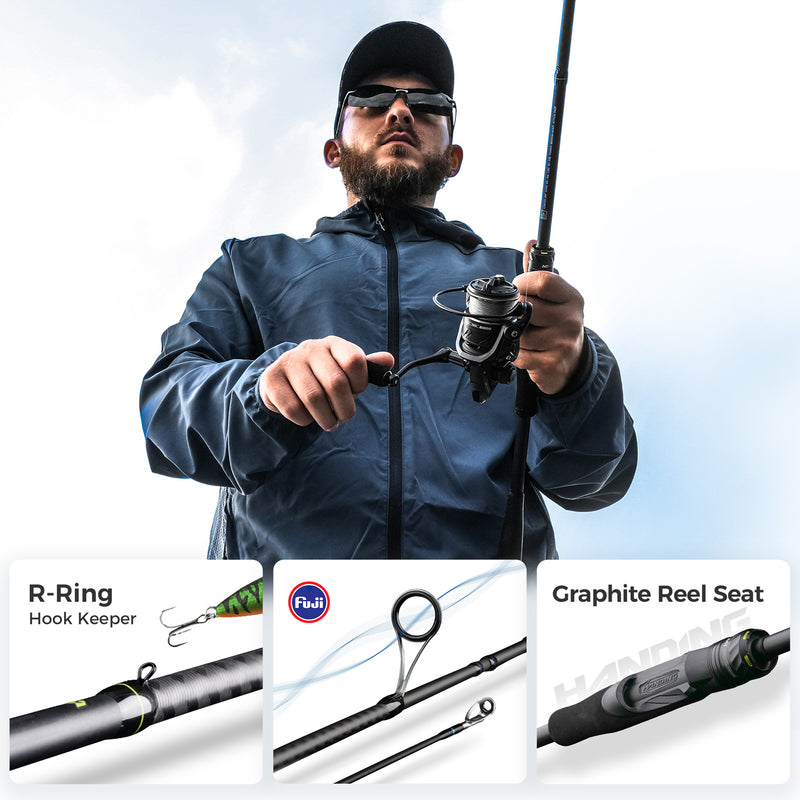Unlock the Secret to Choosing the Perfect Fishing Rod That Will Hook You!
Choosing the right fishing rod is essential for both beginners and seasoned anglers alike. The right rod can significantly enhance your fishing experience and increase your chances of landing that prized catch. Whether you’re casting from the shore or out on a boat, the fishing rod is your direct connection to the water and the fish below. In this article, we will guide you through the important factors to consider when selecting a fishing rod, helping you make an informed decision that aligns with your fishing style and goals. So, whether you’re looking to cast for bass in a local lake or venture out for ocean fishing, read on to find the perfect rod that will make your fishing adventures memorable.

Understanding Fishing Rod Basics
To make an informed decision, it’s crucial to understand the fundamental components of fishing rods. The length of a rod can significantly influence casting distance and accuracy. Longer rods typically allow for longer casts, making them ideal for surf fishing, whereas shorter rods offer better control for precise casts in tight spaces. Power refers to the rod's strength and is classified into ultralight, light, medium, medium-heavy, and heavy options, each suited for different species and fishing techniques. Action describes the rod's flexibility and is categorized as slow, medium, or fast; a fast action rod bends near the tip, providing quick responsiveness, while a slow action rod bends throughout its length, offering a more forgiving feel. Finally, the material of the rod—most commonly graphite or fiberglass—affects sensitivity and durability. A lightweight graphite rod provides excellent sensitivity for feeling bites, while fiberglass rods are more robust and flexible, making them suitable for beginners.
Types of Fishing Rods
There are several types of fishing rods, each designed for specific fishing techniques and environments. Spinning rods are versatile and easy to use, making them great for beginners; they accommodate a variety of bait types and fish species. Baitcasting rods offer more accuracy and control, preferred by experienced anglers targeting larger species. Fly rods are specialized for fly fishing and come in various lengths and weights, allowing for delicate casts of lightweight lures. Telescopic rods provide portability and convenience, collapsing into a compact size for easy transportation, making them perfect for travelers. Understanding these types will help you select a rod that best fits your fishing endeavors, whether you’re casting from a dock or wading into a river.
Factors to Consider When Choosing a Fishing Rod
When selecting a fishing rod, several factors come into play. Your budget is often the first consideration, as fishing rods can vary significantly in price. Think about how often you plan to fish and the type of fishing you’ll be doing; investing in a quality rod can pay off if you’re an avid angler. The fishing environment is another crucial factor; freshwater fishing rods differ from saltwater rods in materials and corrosion resistance. Also, personal comfort cannot be overlooked; a rod that feels good in your hands and matches your physique will enhance your fishing experience. If possible, try out different rods at a local store to find one that feels right. Additionally, consider the weight of the rod, especially if you plan to fish for extended periods. A lighter rod can reduce fatigue and increase your enjoyment on the water.
Comparing Fishing Rod Options
When it comes to comparing different fishing rods, evaluating performance and specifications is key. Look for rods that match your intended fishing style and target species. Pay attention to the rod’s sensitivity, which will help you detect bites more effectively. User reviews can provide valuable insights into the performance of various rods, though it’s important to focus on features that align with your fishing goals rather than brand names. Take note of the rod’s action, length, and power ratings, and compare them against your unique requirements. Sometimes, seeing the rod in action or discussing with knowledgeable friends can offer a practical perspective on its effectiveness. By prioritizing features that matter most to you, you can confidently narrow down your options and select the right fishing rod.
Final Thoughts on Choosing the Right Fishing Rod
In summary, choosing the perfect fishing rod is a vital step in ensuring a rewarding fishing experience. By understanding the basics of fishing rods, exploring the various types, considering key factors, and effectively comparing options, you can make an informed choice that suits your individual needs. Remember, the right rod enhances your connection to the water and can make all the difference in your success on the fishing front. So take your time, do your research, and enjoy the process of selecting a rod that aligns with your fishing aspirations. With the right gear in hand, you’ll be on your way to creating unforgettable memories on the water.



